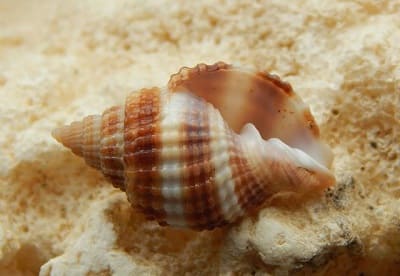Private Scuba Divers › Sea Life Creatures › Underwater Vampires Facts
Fun Facts about Underwater Vampires
A vampire is described as a fictitious or mythical creature that comes back to life and exists by drinking blood from other living animals.
Bloodthirstiness also exists in the seas and oceans. This article contains fun facts and interesting information about vampires that live underwater and survive as real-life bloodsuckers.
Vampires Living in the Sea: Fact or Fiction?
Some organisms actually get their sustenance from the blood of other living animals.
It's a fact... the seas and oceans contain several animal species that do drink blood.
Put another way:
Some oceanic bloodsuckers only exist because they consume strength and energy from a living host.
Let's dive in and reveal them in a list of underwater vampire species.
Pro Tip: The main section contains detailed information about sea life creatures (ocean animals and plants) that have no vampiric or parasitic tendencies.
Marine Leech (Stibarobdella macrothela)
Leeches tend to prefer freshwater environments, such as ponds, slow moving streams, and lakes. But the marine leech, also called a manta leech, has adapted to living a somewhat saline lifestyle.
Stibarobdella macrothela are small, measuring about twelve (12) centimetres in length (5 inches). But, they have no problem sucking the blood from large fishes and reptiles, including:
- Manta rays
- Sea turtles
- Sharks (e.g. angel shark Squatina squatina)
- Shrimps
- Stingray fish (Myliobatiformes)
- Whale shark
Several worldwide reports seem to confirm that the parasitic marine leech will attach itself to most Elasmobranchii. Confirmed documentation from scuba divers show them drinking blood from cartilaginous fish, such as sea skates (family Rajidae) and sawfish.
Mosquitoes of the Sea
In fact, you can find isopods living on land (e.g. woodlice), in fresh water, and a small shrimp-like species living in the sea.
The Gnathia aureusmaculosa is one of the underwater vampires that will suck the blood out of a fish - even while the host species is asleep. Isopods belong with the family Bopyridae and are known for targeting other specimens of marine arthropods, such as:
- Banded coral shrimp
- Copepods
- Horseshoe crabs (Limulidae)
- Zooplanktonic microcrustaceans
The larvae sneaks underneath the shell of an unsuspecting host. There, it will engorge itself on nutrient-rich blood while it continues to grow.
It would be rare not to see these parasites feed in vampiric pairs. The Dracula-like duo will include a giant female and a dwarfed-size male.
The Insatiable Nutmeg Snail
Common nutmeg snails (Cancellaria reticulata) are marine gastropod mollusks that exist in large numbers in the western Atlantic Ocean.
Like the centuries-old Count Dracula himself, the vampiric lifestyle of the nutmeg snail is a creepy one - to say the least.
 Can you imagine creeping up close to someone and ingesting their blood while they sleep?
Can you imagine creeping up close to someone and ingesting their blood while they sleep?
That's exactly how the insatiable nutmeg snail exists, with a few quirky differences:
- This gory mollusk uses chemosensory organs to pinpoint the mucus of their sleeping victims.
- In fact, the cooper's nutmeg (Cancellaria cooperii) are ectoparasites that target Pacific electric rays. The snail buries itself in the sandy ocean floor and patiently waits for a sniff of the mucus trail that they crave so much.
Pro Tip: Most of the sea snail species are small. For example, the lattice shell of the common nutmeg is only six (6) centimetres long (2.5 inches).
Tongue-Eating Parasitic Lice
A list of underwater vampires living in the sea has to include the tongue-eating parasitic louse. The gory lifestyle of this blood-curdling monster might even keep you awake at night.
In fact, Cymothoid isopods are aquatic crustaceans that exist in freshwater environments as well as the traditional marine ecosystems.
Here's the thing:
These isopods feed on the blood of selected fish families (e.g. Clark's anemonefish), after attaching themselves to the fish's tongue. As you may have guessed, eventually the tongue will perish and fall off.
The Cymothoid isopod replaces the old tongue and becomes a new version of their muscular organ. Following that, it can supplement its own bloodlust from the food ingested by the fish.
Sea Lamprey Vampire Fish
Watching carnivorous parasites slurp the life out of unsuspecting victims is horrific. But, that's exactly how the sea lamprey (Petromyzon marinus) uses its rings of sharp teeth.
In place of a jaw, this ancient eel-like fish species has a circular, sucker-like mouth, with lots of teeth. This is how the lamprey attaches itself to drink the blood of small marine invertebrates and fishes.
But wait - there's more:
Most parasitic lampreys are anadromous fish, even though some species spend their whole life in fresh water. After hatching, they usually spend the larval stage filter feeding while they are buried in sediment for several years (up to 7 years in some cases).
Once the lamprey reaches adulthood, it may take another two years before they will mate. Following that, they will die quite soon afterwards.
Pro Tip: There are some forty (40) lamprey fish species in existence, but only eighteen (18) are parasitic. In case you were wondering, there have been reported cases of the lamprey vampire fish attacking humans.
Snails that Syphon Body Fluids
A species of tiny semi-transparent Eulimidae snails have perfected the process of syphoning body fluids from their victims. In general, they target most echinoderm invertebrates, such as:
The bloodshed begins when the snail inserts part of its mouth (shaped like a small straw) into the blood channels of a victim. The snail stays attached to the host as these vampires of the deep feed on its body fluids.
Related Information and Help Guides
- A Simple Introduction to Marine Life Classifications
- Fun and Interesting Facts about Sea Life Creatures
- Marine Biology Words and Phrases Explained for Beginners
Note: The short video [6:43 seconds] presented by Animalogic contains footage about some of the most terrifying bloodsucking animals that live in the seas and oceans.